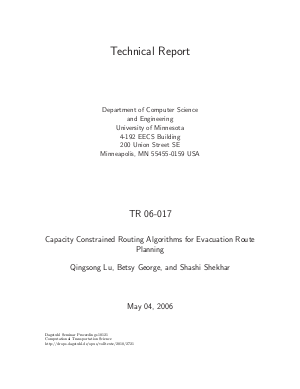Capacity Constrained Routing Algorithms for Evacuation Route Planning
Authors Shashi Shekhar, Betsy George, Qingsong Lu
-
Part of:
Volume:
Dagstuhl Seminar Proceedings, Volume 10121
Part of: Series: Dagstuhl Seminar Proceedings (DagSemProc) - License:
 Creative Commons Attribution 4.0 International license
Creative Commons Attribution 4.0 International license
- Publication Date: 2010-08-06
File

PDF
DagSemProc.10121.3.pdf
- Filesize: 435 kB
- 37 pages
Document Identifiers
Subject Classification
Keywords
- Evacuation
- routes
- spatio-temporal networks
Metrics
- Access Statistics
-
Total Accesses (updated on a weekly basis)
0Document
0Metadata
Abstract
Efficient tools are needed to identify routes and schedules to evacuate affected populations to safety in face of natural disasters or terrorist attacks. Challenges arise due to violation of key assumptions (e.g. stationary ranking of alternative routes, Wardrop equilibrium) behind popular shortest path algorithms (e.g. Dijktra's, A*) and microscopic traffic simulators (e.g. DYNASMART). Time-expanded graphs (TEG) based mathematical programming paradigm does not scale up to large urban scenarios due to excessive duplication of transportation network across time-points. We present a new approach, namely Capacity Constrained Route Planner (CCRP), advancing ideas such as Time-Aggregated Graph (TAG) and an ATST function to provide earliest-Arrival-Time given any Start-Time. Laboratory experiments and field use in Twincities for DHS scenarios (e.g. Nuclear power plant, terrorism) show that CCRP is much faster than the state of the art. A key Transportation Science insight suggests that walking the first mile, when appropriate, may speed-up evacuation by a factor of 2 to 3 for many scenarios. Geographic Information Science (e.g. Time Geography) contributions include a novel representation (e.g. TAG) for spatio-temporal networks. Computer Science contributions include graph theory limitations (e.g. non-stationary ranking of routes, non-FIFO behavior) and scalable algorithms for traditional routing problems in time-varying networks, as well as new problems such as identifying the best start-time (for a given arrival-time deadline) to minimize travel-time.
Cite As Get BibTex
Shashi Shekhar, Betsy George, and Qingsong Lu. Capacity Constrained Routing Algorithms for Evacuation Route Planning. In Computational Transportation Science. Dagstuhl Seminar Proceedings, Volume 10121, Schloss Dagstuhl – Leibniz-Zentrum für Informatik (2010)
https://doi.org/10.4230/DagSemProc.10121.3
BibTex
@InProceedings{shekhar_et_al:DagSemProc.10121.3,
author = {Shekhar, Shashi and George, Betsy and Lu, Qingsong},
title = {{Capacity Constrained Routing Algorithms for Evacuation Route Planning}},
booktitle = {Computational Transportation Science},
series = {Dagstuhl Seminar Proceedings (DagSemProc)},
ISSN = {1862-4405},
year = {2010},
volume = {10121},
editor = {Glenn Geers and Monika Sester and Stephan Winter and Ouri E. Wolfson},
publisher = {Schloss Dagstuhl -- Leibniz-Zentrum f{\"u}r Informatik},
address = {Dagstuhl, Germany},
URL = {https://drops.dagstuhl.de/entities/document/10.4230/DagSemProc.10121.3},
URN = {urn:nbn:de:0030-drops-27216},
doi = {10.4230/DagSemProc.10121.3},
annote = {Keywords: Evacuation, routes, spatio-temporal networks}
}
